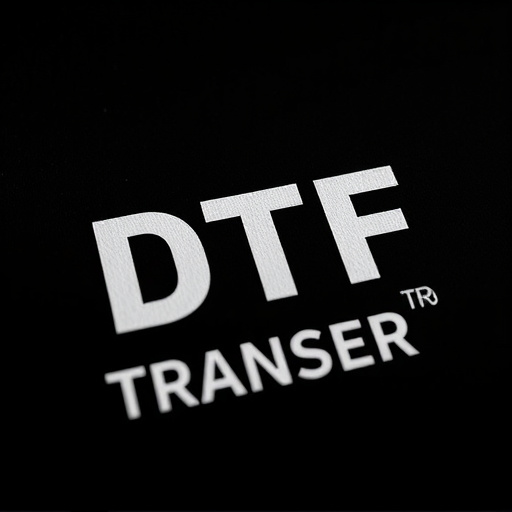DTF (Direct-to-Film) Transfers represent a cutting-edge technology for precise image replication, offering unparalleled detail accuracy without physical contact. Versatile across industries from art to manufacturing, DTF ensures crisp, clear results rivaling originals, with advanced imaging tech and specialized processes capturing intricate designs perfectly. The right transfer materials and seamless data exchange capabilities make DTF a game-changer, revolutionizing operations in sectors demanding high precision printing of thin lines and complex components.
“Unleash the power of precise, detailed designs with DTF Transfers—a game-changer in the world of printing. This article delves into the intricacies of DTF (Direct to Film) transfers, focusing on their ability to reproduce thin lines and intricate details flawlessly. From understanding the technology to selecting the right materials, we guide you through the process. Learn how DTF Transfers are revolutionizing various industries, offering a symphony of possibilities for creating vibrant, high-resolution prints.”
- Understanding DTF Transfers: A Brief Overview
- The Importance of Precision in Thin Line Reproduction
- Key Features of High-Quality DTF Transfers
- Choosing the Right Materials for Optimal Results
- Step-by-Step Guide: Applying and Using DTF Transfers
- Real-World Applications and Case Studies
Understanding DTF Transfers: A Brief Overview

DTF (Direct-to-Film) Transfers represent a cutting-edge technology in printing and replication, offering an unparalleled level of precision for capturing intricate details. This innovative process involves transferring images directly onto film or other media, ensuring that every line, shadow, and texture is reproduced with remarkable accuracy. Unlike traditional methods, DTF transfers don’t require physical contact between the original artwork and the receiving surface, eliminating potential distortions or smudges.
The beauty of DTF Transfers lies in their versatility. They are ideal for a wide range of applications, from fine art printing to industrial marking. Whether it’s reproducing complex linework in engineering drawings or recreating intricate patterns in textile design, DTF technology ensures that the original intent is maintained, resulting in crisp, clear images that rival the quality of the originals. This makes them a game-changer for professionals across various industries who demand the highest level of detail and accuracy.
The Importance of Precision in Thin Line Reproduction

In the realm of graphic reproduction, achieving precision, especially in thin line transfer, is a game-changer. When it comes to DTF (Direct to Film) transfers, every detail matters. The ability to accurately capture and reproduce fine lines is crucial for creating high-quality prints, whether for art exhibition or commercial use. A DTF Transfer that can handle intricate details ensures that the original design’s subtleties are not lost in translation, preserving the artist’s vision intact.
Precision in thin line reproduction involves a meticulous process of setting optimal exposure times, using specialized equipment, and calibrating each step to avoid any smudges or misprints. This level of accuracy is vital for industries like fashion, where intricate patterns and designs require precise lines. It also plays a significant role in technical drawings and blueprints, ensuring that measurements and specifications are conveyed with exactness.
Key Features of High-Quality DTF Transfers

High-quality Digital Transfer (DTF) prints boast several distinctive features that set them apart. One of the most crucial aspects is their ability to reproduce thin lines with remarkable accuracy, ensuring intricate details are captured seamlessly. This precision is achieved through advanced imaging technologies and specialized printing processes, allowing for crisp, clear images even in the tiniest elements of a design.
Additionally, DTF Transfers offer excellent color accuracy and a wide range of vibrant hues, making them ideal for artistic expressions and detailed illustrations. The material used in these transfers is also designed to provide a smooth surface, minimizing imperfections that could disrupt the overall visual appeal. This attention to detail results in final products that faithfully represent the original artwork, whether it’s a delicate sketch or a complex graphic design.
Choosing the Right Materials for Optimal Results

When it comes to achieving precise and detailed transfers, especially for intricate designs with thin lines, selecting the appropriate materials is paramount. In the realm of DTF (Direct to Film) transfers, the choice of media plays a pivotal role in determining the final outcome. High-quality transfer films designed specifically for fine line work offer superior resolution and accuracy. These specialized films are engineered to capture even the tiniest details, ensuring that intricate patterns and delicate lines are reproduced flawlessly.
Opting for materials with exceptional adhesion properties is crucial to achieving a secure bond between the original surface and the transfer. This guarantees that every nuance of the design is maintained during the transfer process, resulting in an indelible and precise reproduction. Additionally, considering factors like temperature sensitivity and ease of application can significantly impact the overall success of the transfer, making it essential for users to choose materials tailored to their specific needs.
Step-by-Step Guide: Applying and Using DTF Transfers

Real-World Applications and Case Studies
In various industries, the ability to accurately reproduce thin lines and intricate details is paramount, especially in fields like manufacturing, automotive, aerospace, and medical devices. Here, DTF (Direct-To-Film) Transfers have emerged as a game-changer. These transfers allow for precise printing of fine lines and tiny components, ensuring high-quality results. For instance, in the automotive sector, DTF technology is utilized to create detailed engine parts and intricate design elements on vehicle bodies, enhancing both aesthetics and functionality.
Case studies demonstrate that DTF Transfers excel in reproducing medical device components, where minute accuracy is crucial. In a recent study, a leading medical equipment manufacturer achieved precise replication of tiny sensors using DTF technology, resulting in improved product performance and patient outcomes. This real-world application showcases the versatility and effectiveness of DTF Transfers across diverse sectors, making them an indispensable tool for achieving excellence in precision printing.














